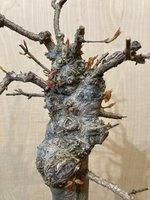bonsaiwood
Mame
Seeing all the recent discussions on challenging Tridents in the forum pages lately has me reaching for a malformed tree in my garden. I picked this up at Lone Pine Nursery in the summer of 2017, just weeks before the North Bay fires broke out. They were having a sale around this time. On my visit I came across an older, broom-style Trident Maple parked on a bench along with other odd-ball trees they were trying to unload. I spoke to a sales lady, and she informed me the tree was routinely hedged back for some time, without much in the way of proper styling/pruning/root work. It was obvious to me the tree was neglected for years and had only received minimal care. Given its structural flaws she provided a nice discount, so I took it home.
Since then, I have not done much more than remove some larger dead branches and re-potted the tree into its original pot in 2019 (I’ll take a picture of the stamp to post soon).
Now on to the bad …




Trunk: Lower half is smooth and rather straight with a large hollow at the base. The upper half is gnarled and scarred. When I look at the tree, it reminds me of a boxer in the 12th round, beaten to a pulp and tired.
Nebari: Terrible … Some larger roots that flare out, then sharply bend downward with ugly knobs at the bends (maybe it was underpotted for years?) ... in any case the tree could use a whole new set of roots.


Branching: No clear direction, some were perhaps threaded but never properly trained. Most, if not all, need to be removed sooner than later.
Taper: Reversed, as seen in the side view pictures above.
One more for "good measure".

Could it have been a nicer looking tree at some point in its life? Probably wishful thinking on my part. In any regard, I would like to think there's a good reason I have kept it alive.
Is there any hope to make something out of this ugly piece of material?
I would love to transform this tree into a sumo shohin Trident, however I feel the need to keep it alive after any major trunk or root reduction outweighs the imagination, for the moment. Sure, it will need a major chop at some point ... so should I ... plant the tree in the ground (or grow box) and bury the ugly roots now to setup a layering and eventual chop later? It seems to me that chopping now would be risky without fresh buds on the lower half of the trunk.
Thread is open to any suggestions. If time would be better spent on something else, please say so. I just hate the idea of wasting a tree .... At worst, I'll plant it in the ground tomorrow with the roots buried and plan for next year.
Since then, I have not done much more than remove some larger dead branches and re-potted the tree into its original pot in 2019 (I’ll take a picture of the stamp to post soon).
Now on to the bad …




Trunk: Lower half is smooth and rather straight with a large hollow at the base. The upper half is gnarled and scarred. When I look at the tree, it reminds me of a boxer in the 12th round, beaten to a pulp and tired.
Nebari: Terrible … Some larger roots that flare out, then sharply bend downward with ugly knobs at the bends (maybe it was underpotted for years?) ... in any case the tree could use a whole new set of roots.


Branching: No clear direction, some were perhaps threaded but never properly trained. Most, if not all, need to be removed sooner than later.
Taper: Reversed, as seen in the side view pictures above.
One more for "good measure".

Could it have been a nicer looking tree at some point in its life? Probably wishful thinking on my part. In any regard, I would like to think there's a good reason I have kept it alive.
Is there any hope to make something out of this ugly piece of material?
I would love to transform this tree into a sumo shohin Trident, however I feel the need to keep it alive after any major trunk or root reduction outweighs the imagination, for the moment. Sure, it will need a major chop at some point ... so should I ... plant the tree in the ground (or grow box) and bury the ugly roots now to setup a layering and eventual chop later? It seems to me that chopping now would be risky without fresh buds on the lower half of the trunk.
Thread is open to any suggestions. If time would be better spent on something else, please say so. I just hate the idea of wasting a tree .... At worst, I'll plant it in the ground tomorrow with the roots buried and plan for next year.











